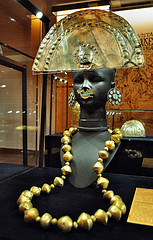Peruvian jewelry is a pre-Columbian culture. Articles of Peruvian jewelry made by the Indians of Peru from as early as the Chavin culture (c. 900 BC-500 BC) until the conquest by the Spanish Conquistadors under Francisco Pizarro in 1532.
Some pieces from the Vicus Valley in the north are closely related to the jewelry from neighbouring Ecuador and Colombia. The pieces are usually made from thin sheet gold, hammered and decorated with «repousse» work and linear, stylized chasing, but some were made by the «cire perdue» process.
Occasional pieces are made of combined gold and silver or with depletion gilding, and some have inlays of shell or turquoise. More than 2,000 examples are in the Miguel Mujica Gallo Collection at the Museo Oro de Peru, in Lima.
 |
 |
 |
 |
The earliest examples are:
Chavin jewelry
(c. 900 BC – 750 BC). The few extant pieces are said to be the earliest known goldwork made in the Americas; they include 3 tall, cylindrical crowns of sheet gold decorated with «repousse» work and several pairs of ear-spools.
Nazca jewelry
made by the Indiai living on the southern coast of Peru, c. AD 300-800. The best-known artifacts are their pottery decorated with elaborate polychrome painting of geometrical motifs and stylized birds, fish, animals, and anthropomorphic heads, but they also made metalwork decorated with such motifs, including jewelry made of cut and hammered thin sheets of gold with «repousse» work.
The examples include bracelets, nose ornaments, mouth masks, and funerary masks. Some pendants were made of shell decorated in mosaic style with colored shell and stones. Much of the extant jewelry was discovered in graves.
Mochica jewelry
made by the Mochica (or Moche) Indians living in the north Peruvian coastal region, c. AD 300-600. Although their culture is known mainly from their architecture and pottery, they made jewelry of gold, silver, copper, bone and shell. Most of the techniques of working metal were known to them by the 4th century AD, including simple and «cire perdue» casting, repouss work, enamelling, and alloying, as well as the making of mosaics with colored stones. Large quantities of such jewelry, for adornment of the living and for burial with the dead, have been found, including bracelets, diadems, pendants, and ear-rings.
Also found are a ceremonial clock made of gold discs and gold gloves worn by deceased nobility and priests.
Chimu jewelry
Articles of Chimu jewelry made by the Chimu Indians, whose culture flourished, c. AD 1000-1500, on the desert coastal legion of northern Peru (the capital being Chan Chan, near modern Trujillo), succeeding that of the Mochicas. The pieces are superior in technique and artistry to those of the Mochicas and Nazcas, reflecting new processes, especially hammering and welding gold of different colors and often decorating with gemstones precisely cut and polished.
The articles included bracelets, necklaces, ear-rings, nose ornaments, and tweezers, and also elaborate, stylized, gold funerary masks, some colored, with anthropomorphic features and pendent gemstones, as well as gold funerary gloves.
The Chimu Indians also made large gold discs (about 30 cm wide) completely decorated with «repousse» work; their purpose is not known. Each piece was unique, as repetition of a design was deemed offensive to their gods. Great quantities of Chimu jewelry were discovered in the 1930s by Briinning in the Lambayeque district of Peru.
 |
 |
 |

|
Inca jewelry
Articles of pre-columbian jewelry made by the Inca Idians of Peru (and also of neighbouring regions of Ecuador, Bolivia, and northern Chile) from c.1200 until the Spanish conquest under Francisco Pizarro and the fall of Cuzco, the Inca capital, in 1533. When the Emperor (Inca) Atahualpa came in 1532 to Cajamarca to meet Pizarro he was imprisoned and a vast amount of gold artifacts (some 6,000 kg.) that had been assembled to ransom him was treacherously taken by Pizarro and much of it was melted and sent as ingots to Spain.
Some gold jewelry was spared destruction owing to its having been buried with the dead and to the disapproval by the Church of plundering graves and tombs (this was, however, done extensively in later centuries).
The Inca jewelry had been made exclusively for the gods and for the Emperor and his Court; the supply of the metal, as of most other resources, was under State control. The pieces included small gold anthropomorphic figures of men and women, often only scantily clothed but wearing replicas jewelry.





